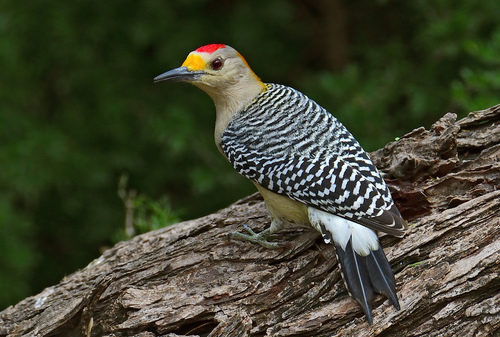
Golden-fronted Woodpecker
The Golden-fronted Woodpecker (*Melanerpes aurifrons*) is a medium-sized woodpecker found in North and Central America. It is known for its striking plumage, featuring a bright golden-yellow nape and a red crown (in males). This species plays a crucial role in its ecosystem by controlling insect populations and creating nesting cavities used by other birds and small mammals. Golden-fronted Woodpeckers are also culturally significant in some regions, appearing in folklore and local traditions. They are relatively common and adaptable, thriving in both natural woodlands and human-modified environments.
22-26 cm
Length
42-46 cm
Wingspan
Least Concern
Conservation Status
Distribution
The Golden-fronted Woodpecker's range extends from the south-central United States (primarily Texas and Oklahoma) south through Mexico and into Central America, reaching as far as northern Nicaragua. They are generally non-migratory, although some populations may exhibit local movements in response to food availability.
Lifespan
4-5 years (wild); up to 10 years (captivity)
Golden-fronted Woodpecker's Habitat
Habitat Types
Woodlands, Savannas, Scrublands, Riparian areas, Urban parks
Climate Zones
Temperate, Subtropical, Tropical (in Central America)
Adaptations
Golden-fronted Woodpeckers have strong, chisel-like beaks for excavating wood and extracting insects. Their zygodactyl feet (two toes pointing forward and two backward) provide a secure grip on tree trunks and branches. They also have stiff tail feathers that act as a prop when climbing.
Variations
Several subspecies are recognized, differing slightly in plumage coloration and size. For example, populations in drier regions tend to be paler overall.
Appearance
Breeding Plumage
Plumage remains relatively consistent throughout the year.
Seasonal Feather Changes
Minor; some individuals may show slightly brighter colors during the breeding season.
Sex Based Plumage Differences
Males have a red crown patch, while females have a gray or buffy crown. Both sexes have the golden-yellow nape.
Notable Features
Golden-yellow nape, Black and white barred back, Red crown patch (males only), Strong, chisel-like beak
Diet and Feeding
Primary Foods
Insects, Beetle larvae, Ants, Fruits, Nuts, Seeds
Foraging Behavior
Golden-fronted Woodpeckers primarily forage on tree trunks and branches, using their beaks to probe crevices and excavate wood for insects. They also glean insects from foliage and occasionally feed on the ground. They are known to cache food, particularly nuts, in tree cavities.
Specializations
Their long, barbed tongue, coated with sticky saliva, helps them extract insects from deep within wood. Strong neck muscles allow for powerful pecking.
Seasonal Diet Variations
Diet shifts seasonally based on food availability. Insects are more prevalent in the diet during the warmer months, while fruits, nuts, and seeds become more important in the fall and winter.
Behavior
Social Structure
Generally found in pairs or small family groups. They are not highly social but may congregate at abundant food sources.
Communication
Loud, rattling calls ('churr'), Drumming on wood (territorial and communication), Visual displays (head bobbing, crest raising)
Migration
Mostly non-migratory, but some populations may make short-distance movements in response to food availability or severe weather.
Territorial or Group Behaviors
Golden-fronted Woodpeckers are territorial, defending their nesting and foraging areas from other woodpeckers. Pairs typically maintain a year-round territory.
Conservation
Threats
Habitat loss (deforestation, urbanization), Competition with invasive species (e.g., European Starlings for nest cavities), Pesticide use (reducing insect prey)
Protection Programs
Habitat conservation and restoration efforts, Monitoring of populations
Local National Laws
Protected under the Migratory Bird Treaty Act in the United States.
Population Trend
Stable
Population Estimates
Global population estimated at 8,200,000
Interesting Facts
They often reuse nest cavities
This helps conserve energy and provides ready-made homes for future breeding seasons.
They can stick out their tongues nearly 2 inches past the tip of their beak
This adaptation is crucial for extracting insects from deep crevices.
They have been observed using tools.
There are rare reports of them using twigs to extract insects.
Faqs about Golden-fronted Woodpecker
What do Golden-fronted Woodpeckers eat?
They eat a variety of insects, fruits, nuts, and seeds. Their diet changes with the seasons.
Where do they nest?
They nest in cavities that they excavate in trees.
Are they endangered?
No, they are classified as 'Least Concern' by the IUCN.
How can I attract Golden-fronted Woodpeckers to my yard?
Providing a source of water, planting native trees and shrubs, and offering suet feeders can help attract them.
Copyright @ Nature Style Limited. All Rights Reserved.
 English
English